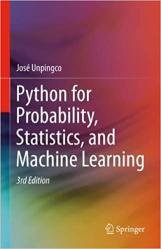 Название: Python for Probability, Statistics, and Machine Learning, 3rd Edition
Название: Python for Probability, Statistics, and Machine Learning, 3rd EditionАвтор: Jose Unpingco
Издательство: Springer
Год: 2022
Страниц: 524
Язык: английский
Формат: pdf (true), epub
Размер: 56.7 MB
Using a novel integration of mathematics and Python codes, this book illustrates the fundamental concepts that link probability, statistics, and machine learning, so that the reader can not only employ statistical and machine learning models using modern Python modules, but also understand their relative strengths and weaknesses. To clearly connect theoretical concepts to practical implementations, the author provides many worked-out examples along with "Programming Tips" that encourage the reader to write quality Python code. The entire text, including all the figures and numerical results, is reproducible using the Python codes provided, thus enabling readers to follow along by experimenting with the same code on their own computers.
Modern Python modules like Pandas, Sympy, Scikit-learn, Statsmodels, Scipy, Xarray, Tensorflow, and Keras are used to implement and visualize important machine learning concepts like the bias/variance trade-off, cross-validation, interpretability, and regularization. Many abstract mathematical ideas, such as modes of convergence in probability, are explained and illustrated with concrete numerical examples. This book is suitable for anyone with undergraduate-level experience with probability, statistics, or Machine Learning and with rudimentary knowledge of Python programming.
Python is fundamental to data science and machine learning, as well as an ever-expanding list of areas including cybersecurity, and web programming. The fundamental reason for Python’s widespread use is that it provides the software glue that permits easy exchange of methods and data across core routines typically written in Fortran or C.
Python is a language geared toward scientists and engineers who may not have formal software development training. It is used to prototype, design, simulate, and test without getting in the way, because Python provides an inherently easy and incremental development cycle, interoperability with existing codes, access to a large base of reliable open-source codes, and a hierarchical compartmentalized design philosophy. Python is known for enhancing user productivity, because it reduces the development time (i.e., time spent programming).
Python is an interpreted language. This means that Python codes run on a Python virtual machine that provides a layer of abstraction between the code and the platform it runs on, thus making codes portable across different platforms. For example, the same script that runs on a Windows laptop can also run on a Linux-based supercomputer or on a mobile phone. This makes programming easier, because the virtual machine handles the low-level details of implementing the business logic of the script on the underlying platform.
Contents:
1. Getting Started with Scientific Python
2. Probability
3. Statistics
4. Machine Learning
Скачать Python for Probability, Statistics, and Machine Learning, 3rd Edition